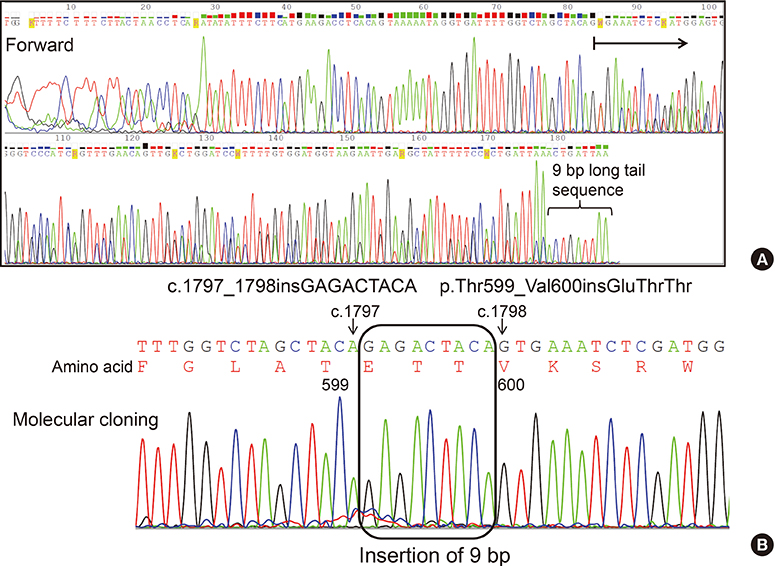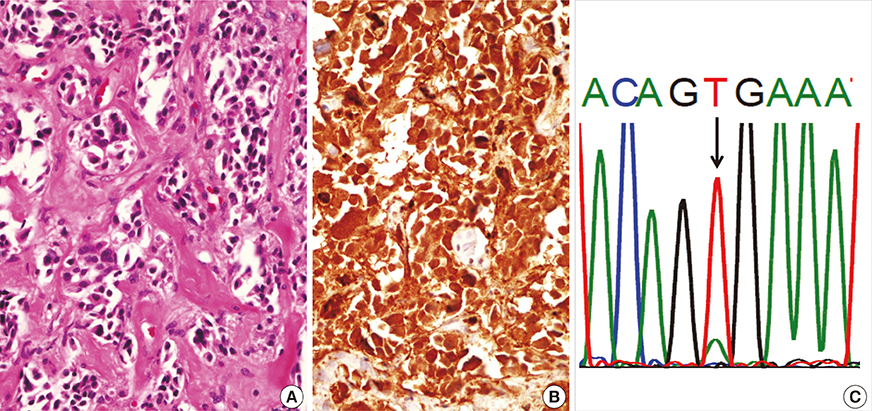J Korean Med Sci.
2014 Aug;29(8):1054-1060. 10.3346/jkms.2014.29.8.1054.
Clinicopathological Features of Rare BRAF Mutations in Korean Thyroid Cancer Patients
- Affiliations
-
- 1Department of Hospital Pathology, College of Medicine, The Catholic University of Korea, Seoul, Korea. ckjung@catholic.ac.kr
- 2Department of Surgery, College of Medicine, The Catholic University of Korea, Seoul, Korea.
- KMID: 2129598
- DOI: http://doi.org/10.3346/jkms.2014.29.8.1054
Abstract
- The most common BRAF mutation in thyroid cancer is c.1799T>A (p.Val600Glu), and other BRAF mutations are rarely reported. We investigated the clinicopathological features of thyroid cancer with rare BRAF mutations. A total of 2,763 patients with thyroid cancer underwent molecular testing by direct DNA sequencing for mutations in BRAF exon 15. Among them, 2,110 (76.4%) had BRAF mutations. The c.1799T>A mutation was found in 2,093 (76.9%) of 2,722 papillary carcinomas and in one of 7 medullary carcinomas. Sixteen cases (0.76%) harbored rare mutation types. Five cases had single-nucleotide substitutions, 5 cases had small in-frame deletion or insertion, and one harbored a two-nucleotide substitution. Of these mutations, 2 were novel (c.1797_1798insGAGACTACA, c.[1799T>A; 1801_1812del]). The c.1801A>C mutation was identified in 4 follicular variant papillary carcinomas and one follicular carcinoma. None of the patients with the c.1801A>C mutation showed extrathyroidal extension or lymph node metastasis. The prevalence of rare BRAF mutations was 0.76% of all BRAF-positive thyroid cancers, and the rare mutations were associated with less aggressive pathologic features. Although BRAF mutations are detected exclusively in papillary carcinoma, they are also found in medullary carcinoma and follicular carcinoma.
Keyword
MeSH Terms
-
Base Sequence
Female
Genetic Markers/genetics
Genetic Predisposition to Disease/epidemiology/*genetics
Humans
Incidence
Male
Middle Aged
Molecular Sequence Data
Mutation/genetics
Polymorphism, Single Nucleotide/genetics
Prevalence
Proto-Oncogene Proteins B-raf/*genetics
Rare Diseases/epidemiology/genetics
Republic of Korea/epidemiology
Risk Factors
Thyroid Neoplasms/epidemiology/*genetics/*pathology
Tumor Markers, Biological/*genetics
Genetic Markers
Proto-Oncogene Proteins B-raf
Tumor Markers, Biological
Figure
Cited by 1 articles
-
Molecular Diagnosis for Cytologically Indeterminate Thyroid Nodules
Tae Sook Hwang
Int J Thyroidol. 2015;8(2):153-160. doi: 10.11106/ijt.2015.8.2.153.
Reference
-
1. Nikiforov YE, Nikiforova MN. Molecular genetics and diagnosis of thyroid cancer. Nat Rev Endocrinol. 2011; 7:569–580.2. Jung CK, Im SY, Kang YJ, Lee H, Jung ES, Kang CS, Bae JS, Choi YJ. Mutational patterns and novel mutations of the BRAF gene in a large cohort of Korean patients with papillary thyroid carcinoma. Thyroid. 2012; 22:791–797.3. Trovisco V, Vieira de Castro I, Soares P, Máximo V, Silva P, Magalhães J, Abrosimov A, Guiu XM, Sobrinho-Simões M. BRAF mutations are associated with some histological types of papillary thyroid carcinoma. J Pathol. 2004; 202:247–251.4. Lupi C, Giannini R, Ugolini C, Proietti A, Berti P, Minuto M, Materazzi G, Elisei R, Santoro M, Miccoli P, et al. Association of BRAF V600E mutation with poor clinicopathological outcomes in 500 consecutive cases of papillary thyroid carcinoma. J Clin Endocrinol Metab. 2007; 92:4085–4090.5. Lima J, Trovisco V, Soares P, Máximo V, Magalhães J, Salvatore G, Santoro M, Bogdanova T, Tronko M, Abrosimov A, et al. BRAF mutations are not a major event in post-Chernobyl childhood thyroid carcinomas. J Clin Endocrinol Metab. 2004; 89:4267–4271.6. Den Dunnen JT, Antonarakis SE. Mutation nomenclature extensions and suggestions to describe complex mutations: a discussion. Hum Mutat. 2000; 15:7–12.7. Trovisco V, Soares P, Preto A, de Castro IV, Lima J, Castro P, Máximo V, Botelho T, Moreira S, Meireles AM, et al. Type and prevalence of BRAF mutations are closely associated with papillary thyroid carcinoma histotype and patients' age but not with tumour aggressiveness. Virchows Arch. 2005; 446:589–595.8. Kim WY, Ko YS, Hwang TS, Han HS, Lim SD, Kim WS, Oh SY. A case of multifocal papillary thyroid carcinoma consisting of one encapsulated follicular variant with BRAF K601E mutation and three conventional types with BRAF V600E mutation. Korean J Pathol. 2013; 47:293–298.9. Castro P, Rebocho AP, Soares RJ, Magalhães J, Roque L, Trovisco V, Vieira de, Cardoso-de-Oliveira M, Fonseca E, Soares P, et al. PAX8-PPARgamma rearrangement is frequently detected in the follicular variant of papillary thyroid carcinoma. J Clin Endocrinol Metab. 2006; 91:213–220.10. Pennelli G, Vianello F, Barollo S, Pezzani R, Merante Boschin I, Pelizzo MR, Mantero F, Rugge M, Mian C. BRAF(K601E) mutation in a patient with a follicular thyroid carcinoma. Thyroid. 2011; 21:1393–1396.11. Schulten HJ, Salama S, Al-Mansouri Z, Alotibi R, Al-Ghamdi K, Al-Hamour OA, Sayadi H, Al-Aradati H, Al-Johari A, Huwait E, et al. BRAF mutations in thyroid tumors from an ethnically diverse group. Hered Cancer Clin Pract. 2012; 10:10.12. Goutas N, Vlachodimitropoulos D, Bouka M, Lazaris AC, Nasioulas G, Gazouli M. BRAF and K-RAS mutation in a Greek papillary and medullary thyroid carcinoma cohort. Anticancer Res. 2008; 28:305–308.13. Cerrato A, De Falco V, Santoro M. Molecular genetics of medullary thyroid carcinoma: the quest for novel therapeutic targets. J Mol Endocrinol. 2009; 43:143–155.14. Oler G, Ebina KN, Michaluart P Jr, Kimura ET, Cerutti J. Investigation of BRAF mutation in a series of papillary thyroid carcinoma and matched-lymph node metastasis reveals a new mutation in metastasis. Clin Endocrinol (Oxf). 2005; 62:509–511.15. Wan PT, Garnett MJ, Roe SM, Lee S, Niculescu-Duvaz D, Good VM, Jones CM, Marshall CJ, Springer CJ, Barford D, et al. Mechanism of activation of the RAF-ERK signaling pathway by oncogenic mutations of B-RAF. Cell. 2004; 116:855–867.16. Hou P, Liu D, Xing M. Functional characterization of the T1799-1801del and A1799-1816ins BRAF mutations in papillary thyroid cancer. Cell Cycle. 2007; 6:377–379.17. Di Cristofaro J, Silvy M, Lanteaume A, Marcy M, Carayon P, De Micco C. Expression of tpo mRNA in thyroid tumors: quantitative PCR analysis and correlation with alterations of ret, Braf, ras and pax8 genes. Endocr Relat Cancer. 2006; 13:485–495.18. Matsuse M, Mitsutake N, Tanimura S, Ogi T, Nishihara E, Hirokawa M, Fuziwara CS, Saenko VA, Suzuki K, Miyauchi A, et al. Functional characterization of the novel BRAF complex mutation, BRAF (V600delinsYM), identified in papillary thyroid carcinoma. Int J Cancer. 2013; 132:738–743.19. De Falco V, Giannini R, Tamburrino A, Ugolini C, Lupi C, Puxeddu E, Santoro M, Basolo F. Functional characterization of the novel T599I-VKSRdel BRAF mutation in a follicular variant papillary thyroid carcinoma. J Clin Endocrinol Metab. 2008; 93:4398–4402.20. Moretti S, Macchiarulo A, De Falco V, Avenia N, Barbi F, Carta C, Cavaliere A, Melillo RM, Passeri L, Santeusanio F, et al. Biochemical and molecular characterization of the novel BRAF (V599Ins) mutation detected in a classic papillary thyroid carcinoma. Oncogene. 2006; 25:4235–4240.21. Kim TY, Kim WB, Rhee YS, Song JY, Kim JM, Gong G, Lee S, Kim SY, Kim SC, Hong SJ, et al. The BRAF mutation is useful for prediction of clinical recurrence in low-risk patients with conventional papillary thyroid carcinoma. Clin Endocrinol (Oxf). 2006; 65:364–368.22. Jung CK, Little MP, Lubin JH, Brenner AV, Wells SA Jr, Sigurdson AJ, Nikiforov YE. The increase in thyroid cancer incidence during the last four decades is accompanied by a high frequency of BRAF mutations and a sharp increase in RAS mutations. J Clin Endocrinol Metab. 2014; 99:E276–E285.23. Trovisco V, Soares P, Soares R, Magalhães J, Sá-Couto P, Sobrinho-Simões M. A new BRAF gene mutation detected in a case of a solid variant of papillary thyroid carcinoma. Hum Pathol. 2005; 36:694–697.24. Lee SR, Jung CK, Kim TE, Bae JS, Jung SL, Choi YJ, Kang CS. Molecular genotyping of follicular variant of papillary thyroid carcinoma correlates with diagnostic category of fine-needle aspiration cytology: values of RAS mutation testing. Thyroid. 2013; 23:1416–1422.25. Jang MA, Lee ST, Oh YL, Kim SW, Chung JH, Ki CS, Kim JW. Identification of a rare 3 bp BRAF gene deletion in a thyroid nodule by mutant enrichment with 3'-modified oligonucleotides polymerase chain reaction. Ann Lab Med. 2012; 32:238–241.26. Santarpia L, Sherman SI, Marabotti A, Clayman GL, El-Naggar AK. Detection and molecular characterization of a novel BRAF activated domain mutation in follicular variant of papillary thyroid carcinoma. Hum Pathol. 2009; 40:827–833.27. Chiosea S, Nikiforova M, Zuo H, Ogilvie J, Gandhi M, Seethala RR, Ohori NP, Nikiforov Y. A novel complex BRAF mutation detected in a solid variant of papillary thyroid carcinoma. Endocr Pathol. 2009; 20:122–126.28. Barzon L, Masi G, Boschin IM, Lavezzo E, Pacenti M, Casal Ide E, Toniato A, Toppo S, Palù G, Pelizzo MR. Characterization of a novel complex BRAF mutation in a follicular variant papillary thyroid carcinoma. Eur J Endocrinol. 2008; 159:77–80.29. Trovisco V, Couto JP, Cameselle-Teijeiro J, de Castro IV, Fonseca E, Soares P, Sobrinho-Simões M. Acquisition of BRAF gene mutations is not a requirement for nodal metastasis of papillary thyroid carcinoma. Clin Endocrinol (Oxf). 2008; 69:683–685.30. Gauchotte G, Philippe C, Lacomme S, Léotard B, Wissler MP, Allou L, Toussaint B, Klein M, Vignaud JM, Bressenot A. BRAF, p53 and SOX2 in anaplastic thyroid carcinoma: evidence for multistep carcinogenesis. Pathology. 2011; 43:447–452.
- Full Text Links
- Actions
-
Cited
- CITED
-
- Close
- Share
- Similar articles
-
- Clinicopathological Features of Rare BRAF Mutations in Korean Thyroid Cancer Patients
- Association between BRAF(V600E) Mutations and Clinicopathological Features of Papillary Thyroid Microcarcinoma (PTMC)
- The Significance of TROP2 Expression in Predicting BRAF Mutations in Papillary Thyroid Carcinoma
- Expressions of miRNAs in Papillary Thyroid Carcinoma and Their Associations with the BRAFV600EMutation and Clinicopathological Features.
- Prevalence of the B Type Raf Kinase V600E Mutation in Cytologically Indeterminate Thyroid Nodules: Correlation with Ultrasonographic and Pathologic Features




